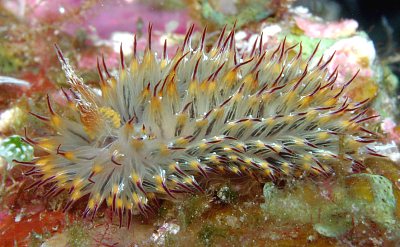
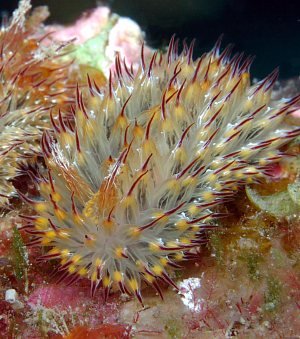
Janolus toyamaensis
Baba and Abe, 1970
Order: NUDIBRANCHIA
Suborder: ARMININA
Family: Zephyrinidae
DISTRIBUTION
Japan [both Japan Sea and Pacific coasts].
PHOTO
Kerama Islands, Okinawa, Japan, Depth: 10m, 8 Mar 2002. Size approx: 20mm. Photos: Jun Imamoto
Typical shape for a Janolus, with an inter-rhinophoral crest and many tapering cerata, which are cast off [see autotomy] when the animal is stressed. The body is transluent clear with a grey or greenish tinge. All parts of the body, and the cerata have short scattered opaque white lines. Baba & Abe also report some dark brown spots on the sides of the body and edge of the foot. They also describe the inter-rhinophoral rest as black, but in this photo it is yellow. The cerata have a narrow tapering reddish-brown tip, below which is a yellowish patch. The rest of the ceratal is translucent clear, through which can be seen the dark green duct [or ducts]of the digestive gland. Grows to at least 20mm in length. Originally found on the Japan Sea coast of Honshu Island, records here from Okinawa, suggest a wide distribution in the Japanese region.
Reference:
• Baba, K. & Abe, T. (1970) Two new species of Janolidae from Toyama Bay, Japan (Gastropoda: Nudibranchia). The Veliger, 13(1): 63-66.
Rudman, W.B., 2003 (April 13) Janolus toyamaensis Baba and Abe, 1970. [In] Sea Slug Forum. Australian Museum, Sydney. Available from http://www.seaslugforum.net/find/janotoya
Related messages
Janolus toyamaensis from western India
April 25, 2010
From: Vishal Bhave
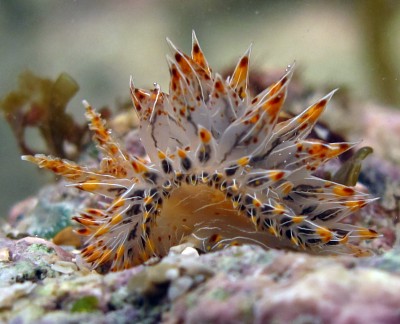
Concerning message #9016:
Dear Bill,
I think it resembles Janolus toyamaensis in its external coloration and white lines. Their is single species of Janolus reported from this area previously by Eliot in 1909 - Okhamandals paper; as Antiopella indica (Eliot, 1909).
Locality: Rocky patch, Okha, Gujarat, 0.2 meters, Gujarat, India, Gulf of Kuchchh, 02 April 2010, Intertidal shallow pool with lots of algae. Length: 21 mm. Photographer: Vishal Bhave.
Thank You.
Vishal Bhave
vishalbhave@gmail.com
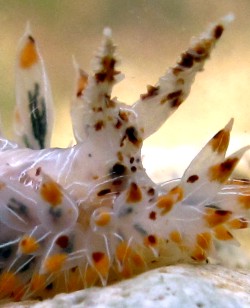
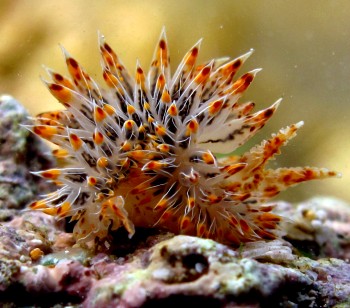
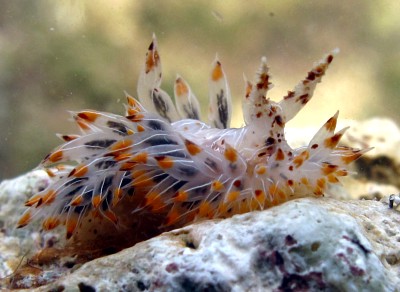
Dear Vishal,
This is an interesting find. It certainly fits the external description of Janolus toyamaensis, which is known only from the Japanese region at present. However there is the possibility it is also the animal named Antiopella indica by Eliot. Firstly it was found at Okha, and secondly, Eliot described that "the parts of the back near [the cerata] seem to be marked with faint light stripes running towards the margin.' This suggests it may have had white lines.
Unfortunately the specimens in this small collection reported on by Eliot were not accompanied by any information on the living animals so their true colour is unknown. I would consider that without a colour description, there is no way we can identify Eliot's species as it is possible that a number of species of Janolus can be found in the region. My feeling is that you would be best using Baba's name J. toyamaensis
Eliot, C. N. E. 1909. Report on the nudibranchs collected by Mr. James Hornell at Okhamandal in Kattiawar in 1905-6. In: J. Hornell: Report to the government of Baroda on the marine zoology of Okhamandal Part 1: 137-145.
Best wishes,
Bill Rudman
Janolus toyamaensis from Japan.
April 15, 2003
From: Jun Imamoto

Dear Bill,
Here is a sea slug, Janolus toyamaensis, which I observed in 2002, which I would like to contribute to the Forum.
Date: Location: Okinawa, Kerama Islands, Japan, Depth: 10m, 8 Mar 2002, Size approx: 20mm. Temperature: 22C. Photos: Jun Imamoto
Best Regards,
Jun Imamoto
http://umiushi.zive.net/
imamoto@wips.co.jp

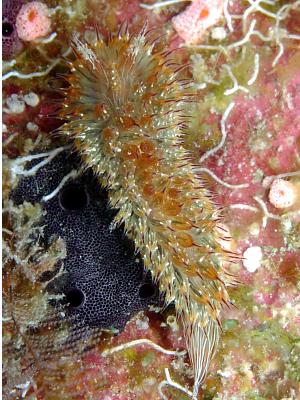
Thanks Jun,
This is an interesting new addition to the Forum
Best wishes,
Bill Rudman
